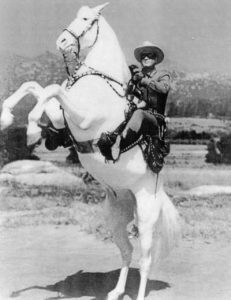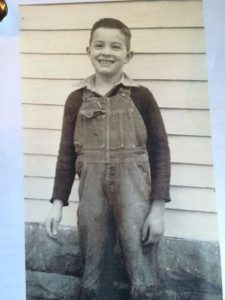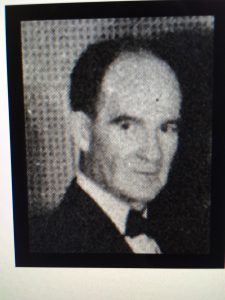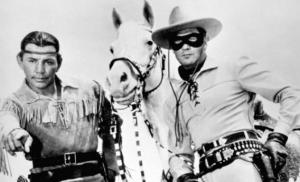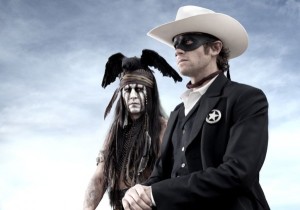Thrilling Days of Yesteryear
The Great Depression
Maybe some of you remember January,1933. Or maybe not.
It was the time of the Great Depression, and our country and people were in a real mess.
The Stock Market had crashed and the unemployment rate was 25%. Crop prices had fallen 60% and people, with little faith in government or Wall Street, were standing in lines to get food.
They had lost faith in about everything and many felt that what they really needed was a savior.
When I saw a tiny article on a back page of our local paper, entitled “Fred Foy dies at age 89,” I was moved to tell you about a surprising savior who, I believe, really did help people emerge from the Great Depression.
Who Was The Savior?
No, I’m not talking about Franklin Roosevelt, even though he qualifies.
Instead, the savior I want to talk about is The Lone Ranger, whose radio program was first broadcast in January,1933!
And I’ll make it clear later why he was the savior.
Fred Foy was the radio announcer who gave the introduction to the Lone Ranger radio program 3 times a week for over 10 years on Station WXYZ in Detroit.
Some of you may be able to say the introduction from memory! And with the William Tell Overture racing through your head!
“Hi Yo Silver” “A fiery horse with the speed of light, a cloud of dust and a hearty “Hi Yo Silver!” The Lone Ranger. With his faithful Indian companion Tonto, the daring and resourceful masked rider of the plains, led the fight for law and order in the early western U.S. Nowhere in the pages of history can one find a greater champion of justice. Return with us now to those thrilling days of yesteryear. The Lone Ranger rides again!
Who Listened To/Watched the Lone Ranger?
 By late 1933 millions of men, women, youth, and children were listening on their battery radios to the story of a hero.
By late 1933 millions of men, women, youth, and children were listening on their battery radios to the story of a hero.
And later, when I was 9 years old, I was among them. This photo is unusual because it shows me in overalls without my Lone Ranger Badge, which was almost always there. I’m sure, in this case, my mother made me take it off to go to church.
And people would continue to listen, to read, and to watch…
- Over 3000 radio episodes in a 21-year period- on 249 radio stations.
- Four television serials from 1937 to 1957(221 episodes)
- Five movies over a span of almost 50 years (1956-2013)
- 18 Novels, Comic Strips and Comic books read by 75 million people
Who Created the Lone Ranger Program?
George Trendle, a ruthless lawyer and owner of radio station WXYZ Detroit, told a colleague that he wanted a program about a western hero to keep his radio station from going under in the depression.
Fran Striker, a prolific writer who had already written some episodes about a masked western “Robin Hood,” was hired by Trendle- and the Lone Ranger was born!
One of Striker’s co-workers estimated that over the next 20 years, Striker wrote 60,000 words a week for the Lone Ranger program and ancillaries-equivalent to the Bible every three months.
In 1934, with the Lone Ranger enjoying ever increasing popularity, Striker was pressured by Trendle- in return for preserving his steady job- to sign over his rights to the Lone Ranger for $10– which he did!
After that, Trendle always claimed credit as the creator of the Lone Ranger.
Upon retirement in Detroit in 1954 (age 70), Trendle finally sold the rights to the Lone Ranger to the Wrather Corporation for over $3 million, and threw Striker a bone by giving him $4000.
Who Were the Actors Who Played The Lone Ranger?
Earl Glaser, the first radio Lone Ranger, didn’t look the part, so Trendle kept him away from the public and his name secret. Many other radio actors followed Glaser.
Arguably the best TV Lone Ranger was Clayton Moore, a former circus acrobat, who told Trendle when he was interviewing for the job. “Mr. Trendle, I AM the Lone Ranger.”
In 1985, Moore said, “I’ll wear the white hat for the rest of my life. The Lone Ranger is a great character, a great American. Playing him has made me a better person.”
And the worst Lone Ranger ever was probably Klinton Spilsbury. His voice had to be dubbed for a 1981 movie, which was a disaster, losing $11 million.
Spilsbury received the Raspberry Award for “worst new star” of that year, and never acted again.
A Word About Tonto
Interestingly, Tonto’s radio voice was that of John Todd, a portly, middle-aged bald headed Irishman and former Shakespeare actor, who looked absolutely nothing like the image he created on the air.
Trendle occasionally slapped a wig on Todd for public appearances as Tonto, but, as you might expect, that didn’t go over very well.
Jay Silverheels, a descendant of the Mohawk Indians, accepted the TV role of Tonto in 1949, and played the role with grace and nobility. It is not difficult– with the benefit of a different time– to find negative stereotypes in the Lone Ranger radio and TV programs.
However, as an avid listener/viewer, I always felt that The Lone Ranger and Tonto’s relationship was one of mutual respect, kindness toward each other, and cooperation.
When each called the other “Kemosabe” (meaning “trusted friend”), I believed it.
So Why Was The Lone Ranger a Savior?
In its heyday, 10-15 million people (at least half of them adults) listened to the Lone Ranger, a hero who gave them what they needed–to be uplifted, to have hope, and to escape from worry.
Scholars feel that the Lone Ranger had a profound psychological affect on listeners emerging from the Great Depression.
He was a masked man with strong moral values who fought corrupt and powerful oppressors, and through his exploits they saw possibilities for freedom, clarity, and the capacity to act.
Fran Striker even wrote a Creed for the Lone Ranger, which reflected moral and religious values the people held so dear.
One minister called the Lone Ranger episodes “bible lessons without scripture.”
Striker also wrote Guidelines for the program, which included the ideas that the Lone Ranger never shoots to kill, and he doesn’t cuss, drink, smoke, or kiss a woman!
Could The Lone Ranger Help Us Today?
Our Nation has emerged from the biggest recession in years, but many people still have a depressed feeling about their country and their lives-like those people 82 years ago in 1933.
It appeared that the Disney Corporation had learned a lesson of history when they decided to make a new Lone Ranger Movie in 2012.
If they could have helped the Lone Ranger become our psychological savior again, we would all perhaps be better off, and they could have made a lot of money.
But alas, it was not to be. In their movie– seemingly in an attempt to be modern, politically correct, and re-invent the characters and relationships– the real Lone Ranger was nowhere to be seen.
And his insufficient surrogate took orders from Tonto, cussed a little, and even kissed a woman!
The movie was basically a flop, and we are still in need of a psychological savior.
We can only hope that someday, someone will get it right.



